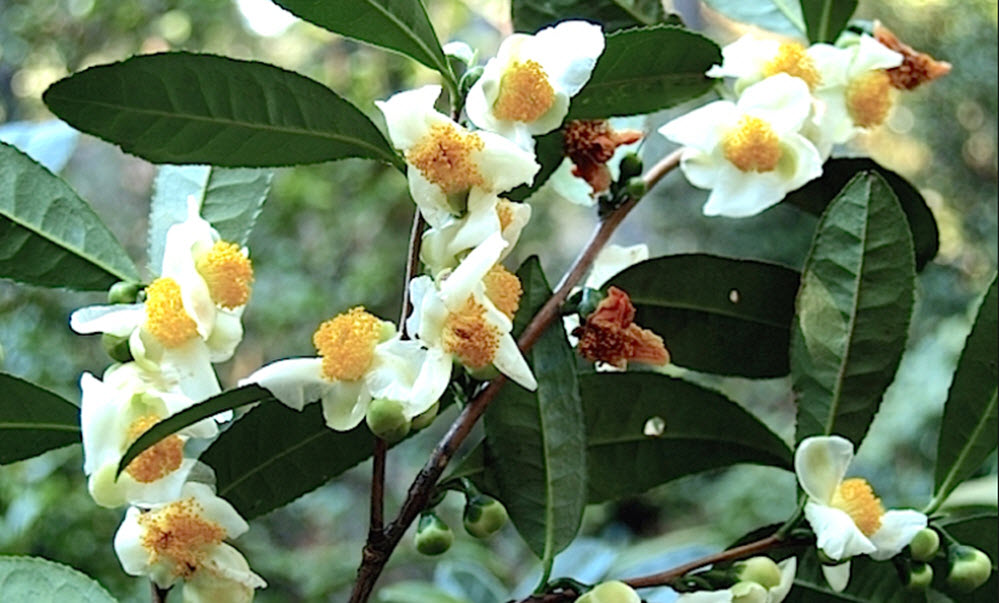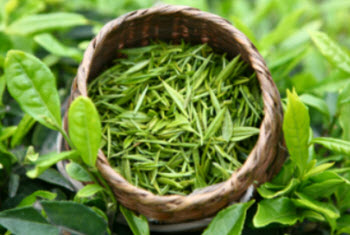Contents
The leaves and buds of the Caminella sinensis is used to produce tea, one of the world’s most widely consumed beverages. Native to Asia, this species can grow either as a shrub or as a tree, depending on the circumstances.
In China, Caminella sinensis has a very long history as a medicinal plant, and it is included in “Shennong Bencaojing”, and old Chinese work about agriculture and medicinal plants. Shennong Bencaojing was written 200-250 AD, but is believed to be based on oral traditions that are considerably older. The original copy from 200-250 AD has not survived into our time, but we know the text through various copies that’s been made throughout the centuries.

Leaves, twigs, stems, and seeds
- When we make tea, we usually use dried tea leaves, and for most types of tea, only the bud (tip) and the first two or three leaves are picked.
- Kukicha is a tea made from twigs and stems instead of leaves.
- In Asia, the seeds of Camellia sinensis are pressed to make tea oil, which also has its place in the folk medicine of the region. The tea oil, which has a sweetish taste, is also used to season food and as a cooking oil.
- Young leaves of Camellia sinensis are used to make Matcha. Matcha tea has a mild smooth flavour.
Scientific classification of the tea plant
| Kingdom | Plantae |
| Order | Ericales |
| Family | Theaceae |
| Genus | Camellia |
| Species | Camellia sinensis |
Properties
Examples of compounds found in tea leaves are caffeine and theanine.
 Freshly picked leaves contain about 4% caffeine, but there are many factors that will impact how much caffeine you actually end up with in your tea cup, such as how the leaves are handled after picking and how you brew your tea. When cups of standard brewed tea are tested, the caffeine content usually falls within the 30 mg – 90 mg span (per cup).
Freshly picked leaves contain about 4% caffeine, but there are many factors that will impact how much caffeine you actually end up with in your tea cup, such as how the leaves are handled after picking and how you brew your tea. When cups of standard brewed tea are tested, the caffeine content usually falls within the 30 mg – 90 mg span (per cup).
Theanine, or more specifically L-theanine, is the compound responsible for the umami flavor of tea. L-theanine is structurally similar to the neurotransmitter glutamate and can bind to glutamate receptors (albeit with lower affinity).
When we drink tea, the theanine increases the levels of certain compounds in our brain, including dopamine, serotonin, glycine, and GABA. Theanine has also been shown to boost the levels of BDNF and NGF in certain parts of the brain.
If it’s L-theanine you’re after, better chose black tea over green tea. In a 2011 study, regular brewed black tea was shown to contain 24 mg of L-theanine per cup, while the regular brewed green tea contained no more than 8 mg / cup.
Blood pressure
A 2013 Cochrane review of randomized controlled trials concluded that long-term black tea consumption is associated with a somewhat lower systolic and diastolic blood pressure. The reduction is small, just one or two mmHg.
Kidney stones
Tea contains oxalate, and the ingestion of oxalate increases the risk of kidney stones.
About the plant
Camellia sinensis is usually grown in tropical and subtropical locations, but you can find tea plantations in certain temperate regions as well, including Scotland.
The tea plant wants full sun or half sun, but also needs at least 130 cm of rainfall (or irrigation) per year, making it unsuitable for many of the drier parts of the tropics and subtropics.
Varieties
The two most commonly grown variants of Camellia sinensis are C. sinensis var. sinensis and C. sinensis var. assamica. Of these two, assamica has the largest leaves.
Two other tea varieties are recognized as well: C. sinensis var. pubilimba and C. sinensis var. dehungensis. They are much less common in the trade and mostly grown for local consumption.
Cultivars
As mentioned above, there are only four recognized variants fo Camellia sinensis. However, the number of cultivars is huge.
Is green tea another species?
No, the tea sold as green tea is of the same species as the black tea. Black tea, green tea, white tea, oolong and pu’er are all Camellia sinensis. The difference in taste and appearance is caused by how the tea has been treated after picking.
Growth pace
Tea plants that grow at a slow pace tend to have more flavorful leaves. This is why many illustrous tea plantations are found at high altitudes.
Properties
| Type | The natural inclination of this plant is to become a tree. On commercial tea plantations, the plants are usually pruned and kept as bushes instead, to make it easier for the pickers to reach the leaves. |
| Root | The root is a taproot. |
| Leaves | 4-15 cm in lenght 2-5 cm in width |
| Flowers | 2.5 – 4 cm in diameter Yellow-white in color Seven or eight petals |
